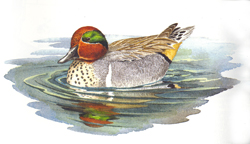Breeding Bird Atlases (BBA)
Find a Bird - BBA1
Breeding Bird Atlas 1 Species Accounts
Green-winged Teal
Anas crecca
Egg Dates
mid-April to late June
Number of Broods
one; may re-lay if first attempt fails.

Although Green-winged Teal are regular breeders and present in Massachusetts in small numbers year-round, they are still considered by most standards to represent a migrant species. Nationally, there has been an upward trend in the number of Green-winged Teal, with the East Coast showing the greatest increase. They breed in small numbers at scattered locations from the outer Cape and Essex County west across the state to Berkshire County. In all seasons, this species shows a predilection for fresh ponds and channels of water with a thick edge of vegetation.
Pair formation begins on the wintering grounds and continues during spring migration, which starts in March. Two or more males may be seen courting a female with vigorous head bobbing and loud whistling notes. The females utter a weak quack. Green-winged Teal prefer to nest in thick, grassy upland areas adjacent to water but will sometimes nest some distance from it. The hen builds a well-concealed nest of soft grasses lined with down in a shallow depression. Usually eight to twelve eggs are laid one per day, with the 21-day incubation period beginning when the last egg is laid. The hen covers the nest when leaving to feed or rest. If the first nest is destroyed, she may renest, although the clutch size is normally smaller. Shortly after hatching, the downy young are led to water by the female. During the rearing process, the brood keeps very close to aquatic cover, seldom venturing out on open water. Four Massachusetts brood dates range from June 7 to July 18. The number of ducklings per brood was four to nine (BOEM, TC). The young fledge at about 44 days old.
The male deserts the female as soon as the clutch is complete. Drakes gather together on a nearby body of water to molt into somber brown eclipse plumage. During this period, they are flightless for about three weeks. They begin to attain their nuptial plumage in late September and October but may have not acquired their full color prior to departure for the wintering grounds.
In late summer, Green-winged Teal gather in sizable flocks that are swelled by migrants from northern breeding areas. Numbers are greatest in October, with many remaining until November. Most depart southward with the advent of freezing weather. The winter range extends along the coast to the southern United States, northern Central America, and some of the Caribbean Islands. Those that remain in Massachusetts for the winter frequent tidal flats and marshes during severe weather or accompany diving ducks to glean bits of vegetation that they bring to the surface.
Map Legend and Data Summary
Atlas 1 data collected from 1975-1979


Note: uncommon to rare and very local in swamps and densely vegetated ponds
Augustus Ben David II



